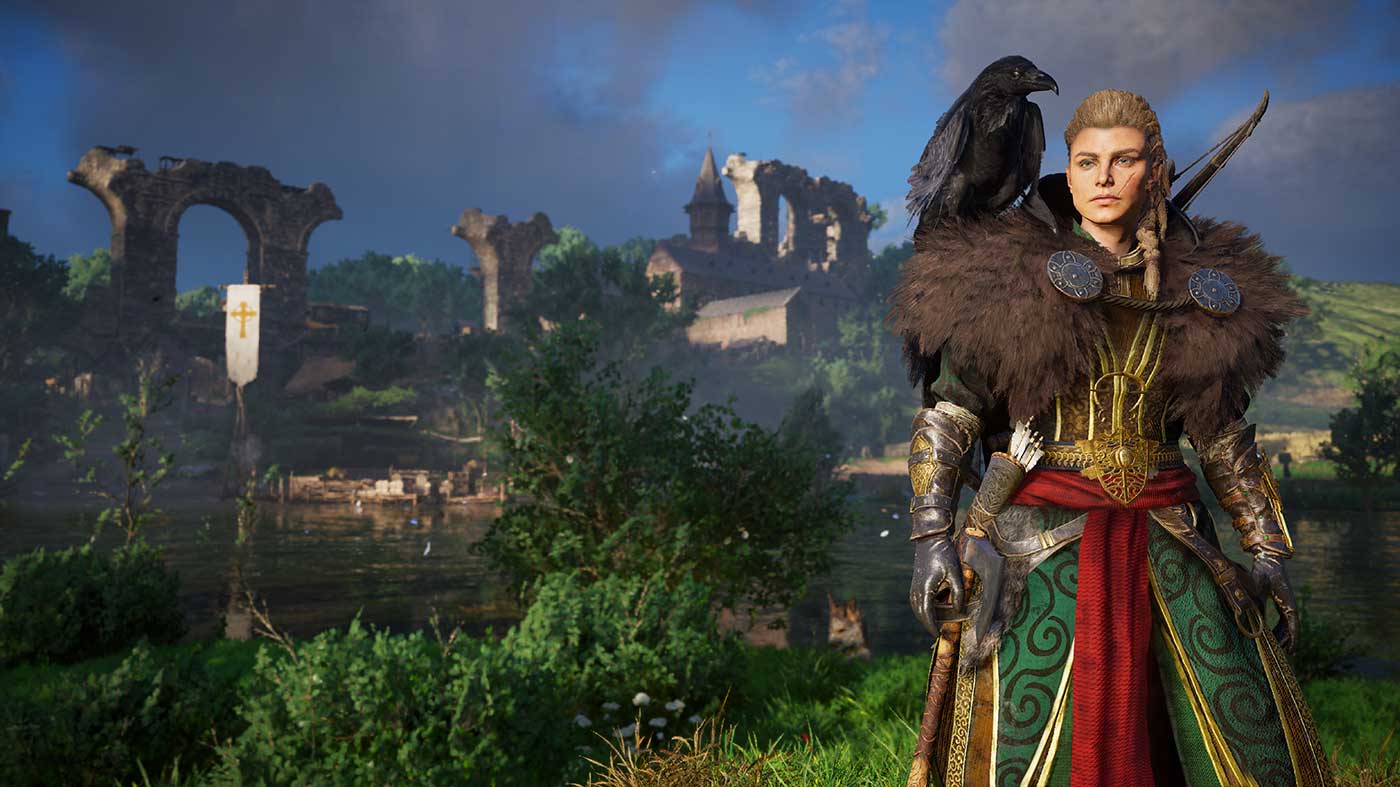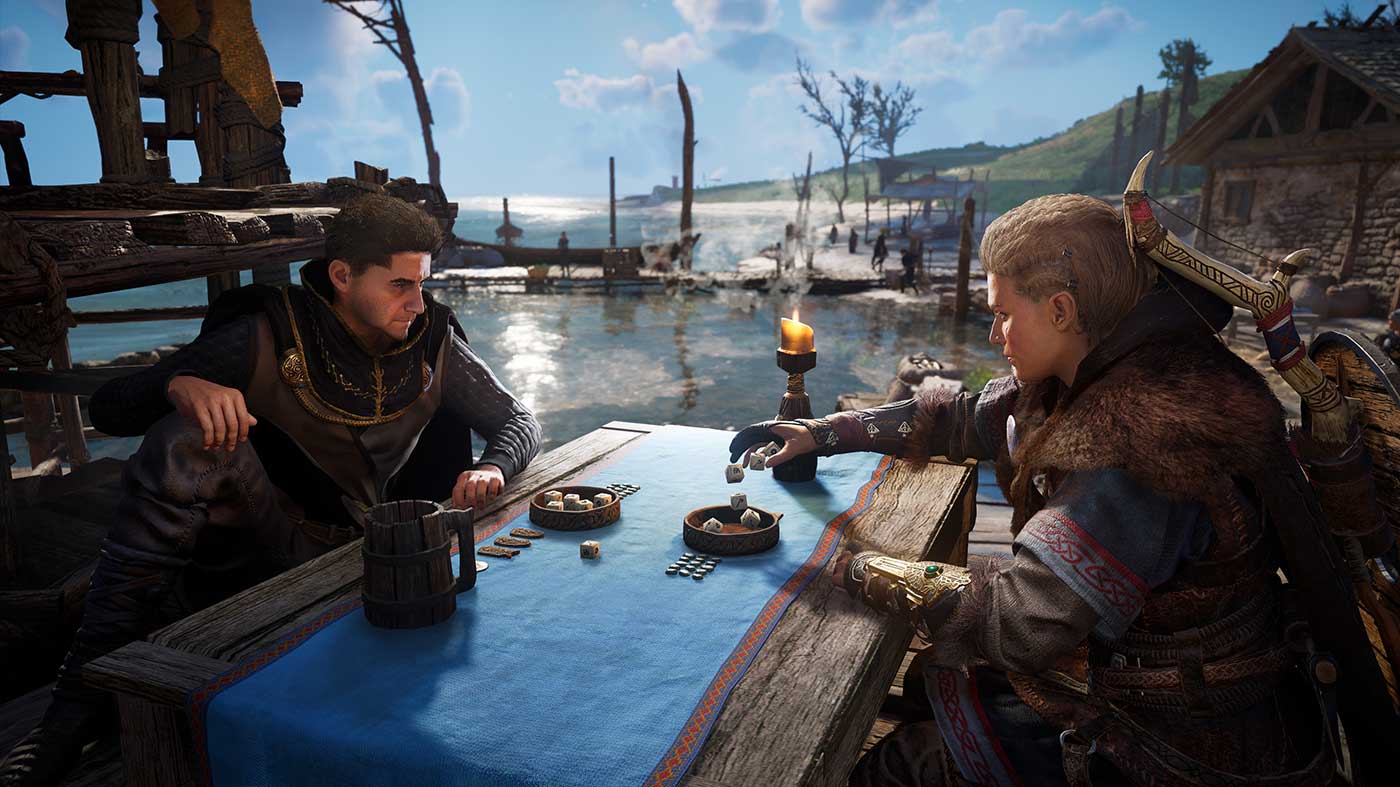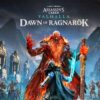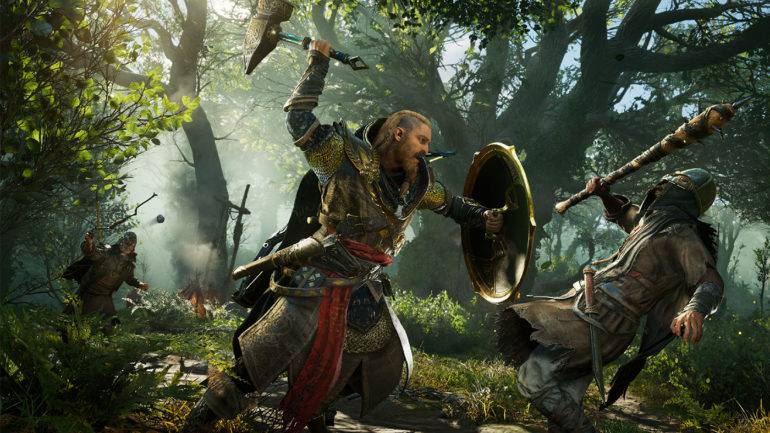There’s a moment in Assassin’s Creed Valhalla where protagonist Eivor is given the hidden blade. It’s an undying symbol of the franchise – a staple that fans have come to expect in every game for the last thirteen years. But Eivor wears it differently to the other Assassin’s throughout the series, much to the chagrin of the person who gives it to him, but still respects what it represents. I can’t think of a better analogue to describe Assassin’s Creed Valhalla. It dramatically departs from both Origins and Odyssey in many ways and harkens back to what many people loved about the first few games. But it’s a tad more complicated than that.
Valhalla takes place in the ninth century across mainly Norway and what would become England. You play as Eivor, a Viking warrior of the raven clan, as they begin their taking of Europe against King Alfred and the Anglo-Saxon faction in England. During their initial settlement, Eivor begins the expansion, forging allegiances with warring factions in different kingdoms to take the continent and expand their presence. In doing so, they embroil themselves in the age-old conflict between the prototypical Assassins, the “Hidden Ones” and their rival faction “The Order of the Ancients.”

Two years ago, I was excited to proclaim that Odyssey presented a story that had me enamoured from beginning to end. Despite my initial apprehension about the setting and mythology the game was drawing from, I’m chuffed to be able to say Valhalla does the same thing. Equal parts political intrigue and family drama, Valhalla has several plot threads and characters that grabbed me from the get-go and never let go. The modern-day plot continues too, and two years ago, I surmised Odyssey was building to something, and oh boy does Valhalla humour me in a big way.
Valhalla’s unique storyline brings with it a unique main quest structure too. In your settlement, Eivor can select a territory to “pledge” to, thus beginning an “arc.” In that arc is a self-contained story (though some elements carry over). Eivor carries out quests and tasks to win that territory over as an ally for his clan. You can sometimes choose which pledge you can take on first, though each one is power graded to give an idea of what order they should be completed in.
This system makes sense – bridging the narrative and gameplay gap beautifully. But it makes Valhalla feel a little bit modular, like a television show. And with that format comes warts and all, such as the filler episodes. While Valhalla’s overall narrative arc is compelling from beginning to end, one or two of these individualised arcs could be removed to improve the game’s pacing. Is Valhalla too long? Yes, it is, but its central gameplay mechanics are strong enough that it only just scrapes over, but some might find it a tad bloated.

Punctuating each arc tends to be a full-blown assault, which is where the Viking experience in Valhalla really comes full circle. Atoning for the morose conquest battles in Odyssey, these marquee battles are a joy to participate in. Whether you’re commanding the battering ram as it explodes through a castle gate, destroying armaments on a castle wall, or just fighting on the ground, the assaults are some of the highlights of Valhalla.
Following more in the footsteps of Origins, Assassin’s Creed Valhalla keeps what worked from the last two games while also reincorporating what’s sorely missed from as early as Assassin’s Creed II. The result is a game that’s less of an RPG – to the point where you won’t have to incessantly sift through equipment, stats, numbers, and levels to work out if an assassination will work properly. Instead, Valhalla rewards skill instead of “playing the game” with numbers. If you enter an area with powerful enemies, it’s theoretically possible to down them but much, much harder. And yes, assassinations work like they used to.
The combat itself is, without a doubt, the most significant achievement in Valhalla. Easily the series best, every move in the game has a hefty weight to it. Eivor can dual wield almost every weapon in any configuration, even the heavier ones, as you progress up the skill tree. With such weight comes careful consideration too, though, and the games twenty-plus enemy types encourage you to be more cautious with your strikes than just mashing. You can parry and counter in Valhalla, just like in previous games, but you can’t just sleepwalk through battles countering like in previous games.

Abilities and skills have been completely revamped in Valhalla too. A starry constellation acts as your “skill tree” which you can respect at any time, offering improvements to stats and unlockable passive skills. Unlike other games, the more substantial combat abilities are tied to collectible tomes, which are hidden in the game world. It’s a choice that makes exploration feel a little more critical, though I feel like it wasn’t completely necessary. The abilities themselves feel like a huge step up from Odyssey, which often had skills bordered on magic. Valhalla, while still fantastical, feels a lot more grounded with its abilities.
And honestly, I’ll never get tired of grabbing enemies with a harpoon before flinging them into a wall or another enemy. Or throwing a flurry of axes at a ring of oncoming enemies. It’s a satisfying combat system with heaps of abilities that never gets old. Oh, and you can decapitate and dismember enemies. Which is barbaric, but so bloody good.
The boat makes a return in Valhalla, except this time it’s more for transport than anything else. Eschewing the previous games’ naval combat, you’ll mainly use your boat to traverse the complex network of rivers throughout England. You can ram other boats at times, but it’s otherwise a transport method rather than another method of combat. The boat is integral to the activities you’ll be performing, too – often to raid monasteries to pillage and plunder materials for your own settlement.

The settlement is the other significant and new addition to Valhalla, but the franchise’s keen fans will recognise Ravensthorpe from any angle. Essentially, Ravensthorpe works similarly to Monteriggioni from Assassin’s Creed II. Using the resources garnered from raids and assaults, Eivor can restore buildings to open up new quest lines, unlock new abilities from it’ sits settlers, and purchase equipment and customisations. It’s lacking the lengthy history that the real-world Monteriggioni had, but it functions pretty much the same. You can customise certain positions with relics and the like, but this feels decidedly old school, and I only say that with praise. You can even feast before a raid to grant your team buffs.
Beyond the main quest, there’s heaps to do in Valhalla, and even though it’s optional, it still feels meaningful. Whether it be flyting, hunting, witch hunting, fishing, or even drinking games, there’s always something to do in England. Flyting is my personal favourite – allowing you to exchange insults that rhyme with someone to improve Eivor’s charisma. Better charisma leads to extra dialogue choices during missions, so it feels like a no brainer.
But side missions are done so differently in Valhalla that I’d be remiss not to talk about them. Called “mysteries” in each region, Valhalla’s side missions are so short that they don’t even make their way into your quest log. They’re commonly short, self-contained stories that take less than five minutes to complete. And while they’re small, they’re often so well-written and so quick-witted that I find it hard to be mad. To get me invested in such a short period is a testament to their writing strength and means they don’t feel like padding.

Both Norway and England are brought to life with beauty in Valhalla too. While not quite as exotic as Egypt and Greece, Valhalla’s England brandishes a different yet equally mesmerising sense of beauty. There was never a point where I thought Valhalla looked bad, though there were moments where I felt the lip-syncing could’ve been a little bit better. It’s not a deal-breaker by any means but having these realistic characters in these beautiful locales slapping their lips together brutishly sometimes takes you out of the mood.
Owing to Valhalla’s general feeling being a throwback, the game is scored by Jesper Kyd for the first time in ten years, since Brotherhood. The result is an ambient score that is equal parts tranquil and haunting. On the other side of the coin, the more action-oriented music is scored by Sarah Schachner and Einar Selvik, who ironically makes the music for the television series Vikings. As you’d expect, these pieces are distinctly unique to Valhalla and help sell that Viking experience the game works so hard to build.
Xbox Series X Impressions
(Words by Brodie Gibbons)
When running at 60 frames per second in full 4K HDR, Valhalla stands up as the most visually pleasing game of the series so far. Although its colour palette is a bit more muted in the early going against a wintery Norway backdrop, the English sun breaks through after a few hours and lifts it up nearer the lush sheen of Odyssey’s Grecian gardens. The lighting is stunning and there aren’t many open-world games that look quite this good in motion.
Load times are vastly improved from Xbox One X to Series X. For example, fast travelling between continents alone shows a staggering difference in speeds. It should be noted that these times were tested independently by James and myself, and therefore the times for continued save in particular could be skewed by our respective progress—James is obviously far ahead of me.
Continuing a game save:
-
- Xbox Series X – 0:17:10
- Xbox One X – 1:29:00
As for sailing the North Sea: England to Norway, the latter of which is the smaller of the two maps takes 0:56.2 on Xbox One X while it only took 0:16:32 on Series X. And the return journey took a staggering 1:32.1 on the older machine and just 0:17.5 on Series X.
And of course, thanks to Quick Resume, all of these loading screens fast become negligible for Series X users once the game has already booted. In just a few short seconds, you’re able to pull Valhalla back up from its suspended state and pick up right where you left off after time away from the game. It’s insane and I can’t get over how convenient the feature really is.
Assassin’s Creed: Valhalla feels like a subtle reversion to how the series felt in its early years, recapturing the old glory of the franchise while bringing forward all of the best parts from recent iterations. The experience is made all the smoother thanks to next-gen hardware.
THE XBOX VERSION OF THIS GAME WAS TESTED ON AN XBOX SERIES X/XBOX ONE X FOR THE PURPOSE OF THIS REVIEW. A DIGITAL REVIEW CODE WAS PROVIDED BY THE PUBLISHER. WE LOVE BRINGING YOU THE BEST GAMING AND TECH BARGAINS. WE MAY GET A SMALL PERCENTAGE OF THE SALE THROUGH AFFILIATE PARTNERSHIPS




